Abstract
We studied the effects of MAbR15.7, an antibody directed against the common beta-chain (CD-18) of a family of neutrophil adherence glycoproteins, on endothelial dysfunction and myocardial injury in a model of myocardial ischemia and reperfusion in cats. Pentobarbital-anesthetized cats were subjected to 1.5 h occlusion of the left anterior descending coronary artery (LAD) and 4.5 h of reperfusion. MI + R resulted in severe myocardial injury and endothelial dysfunction, including significant elevation of plasma creatine kinase (CK) activity, marked myocardial necrosis, high cardiac myeloperoxidase (MPO) activity in ischemic cardiac tissue, and loss of response of LAD coronary rings to the endothelium-dependent vasodilators, acetylcholine (ACh) and A-23187. In contrast, MAbR15.7-treated cats exhibited a lower plasma CK activity at every time point observed after 2 h, a reduced area of cardiac necrosis (2 +/- 1 vs. 30.8 +/- 2.5% of area-at-risk, P less than 0.001), lower MPO activity in the ischemic region (P less than 0.01), and significantly preserved vasorelaxant responses of LAD coronary rings to endothelium-dependent vasodilators, ACh (P less than 0.001), and A-23187 (P less than 0.001). These results indicate that myocardial ischemia and reperfusion induces significant myocardial injury and endothelial dysfunction in the cat involving a CD18-dependent neutrophil adherence mechanism. Inhibition of neutrophil adherence to the endothelium exerts significant protective effects in this model of reperfusion injury.
Full text
PDF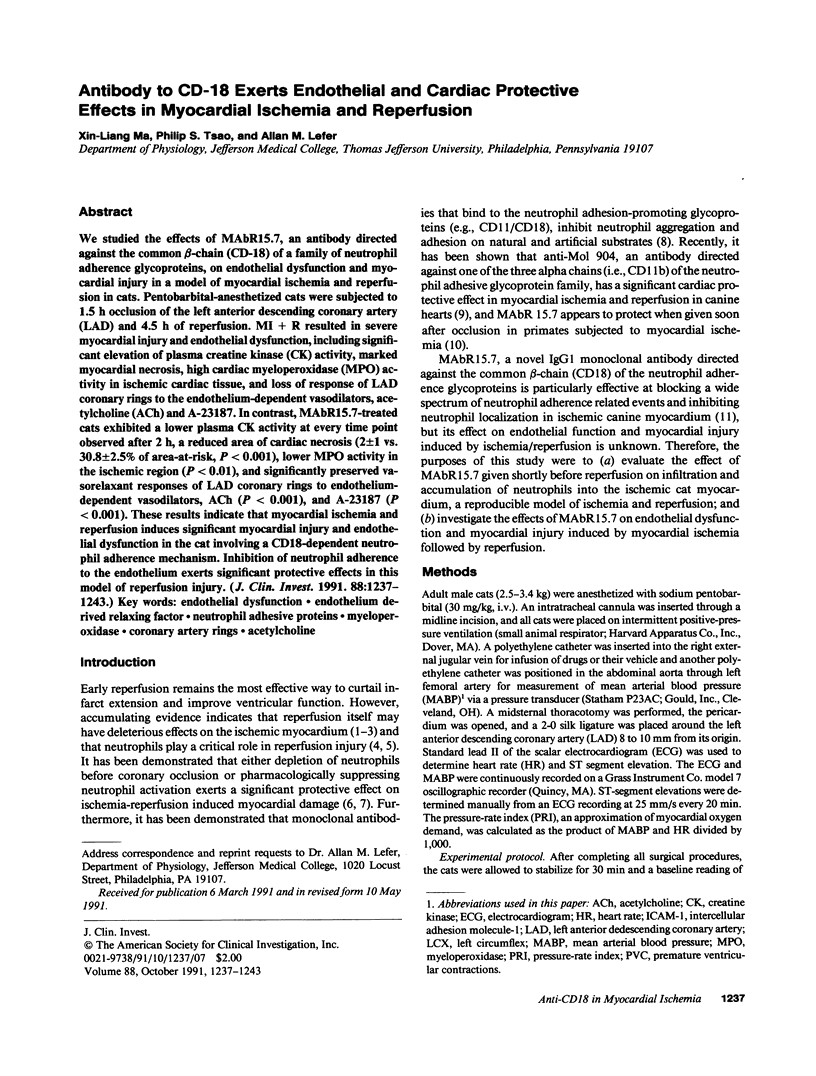
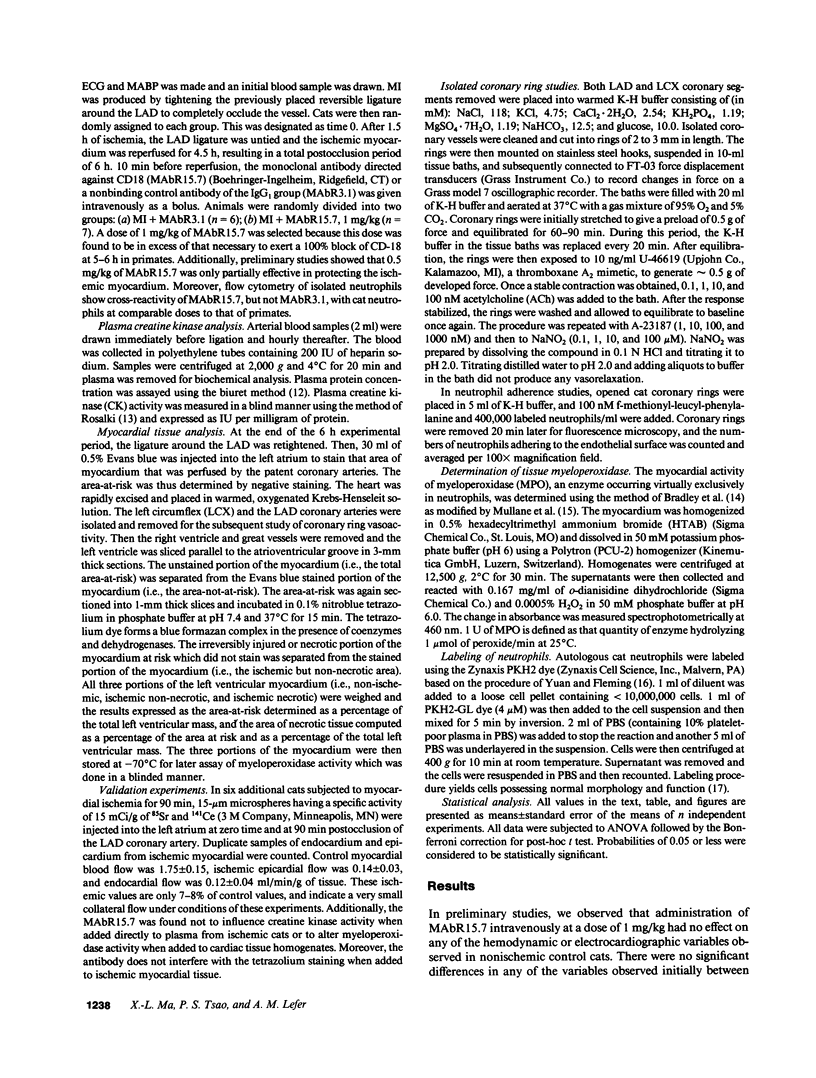
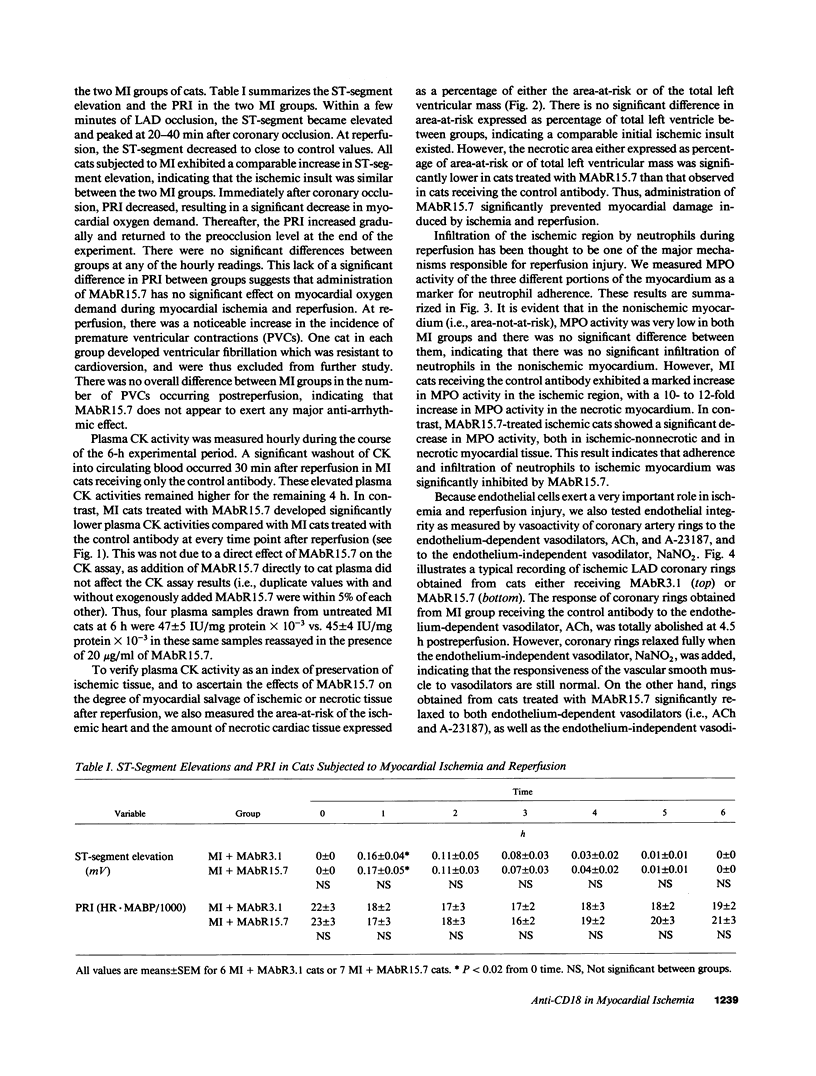
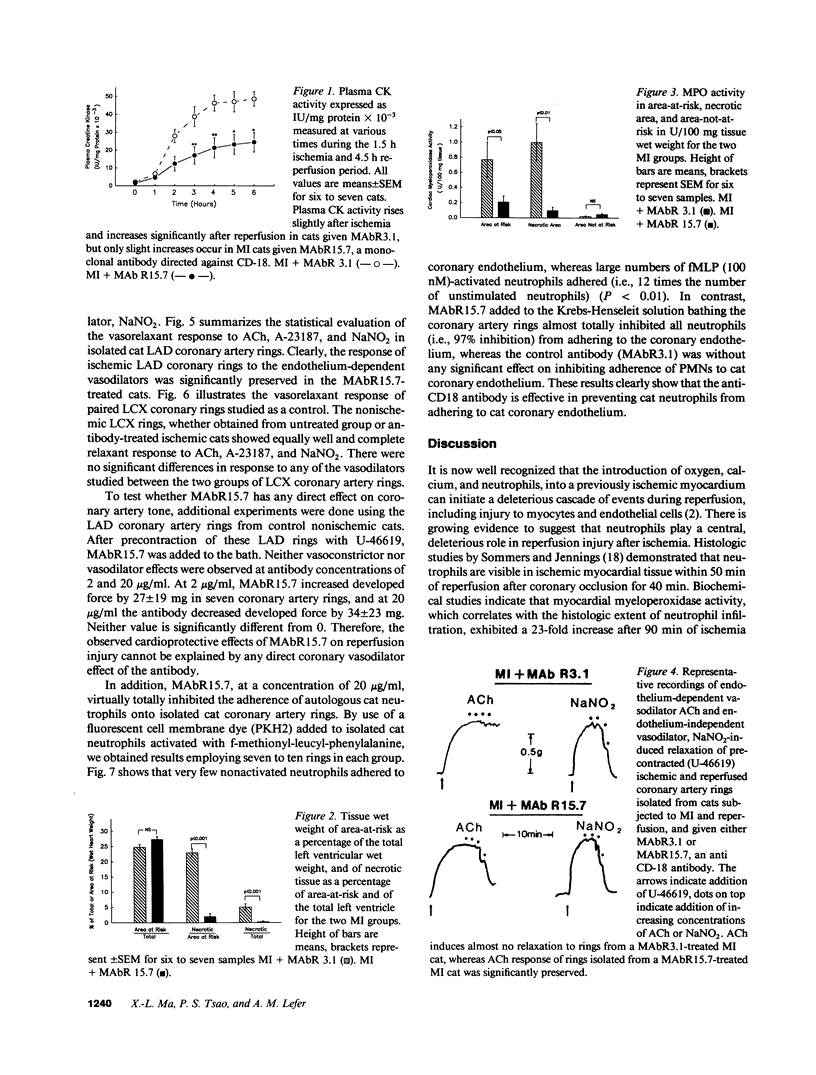
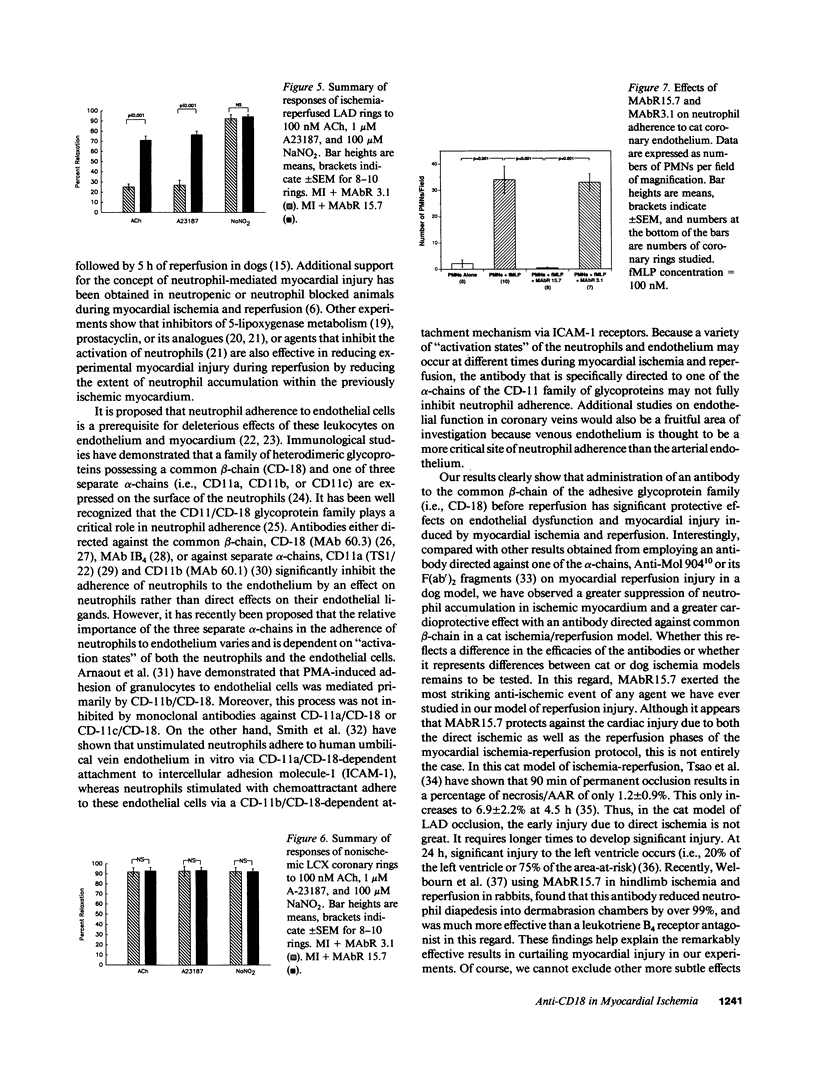
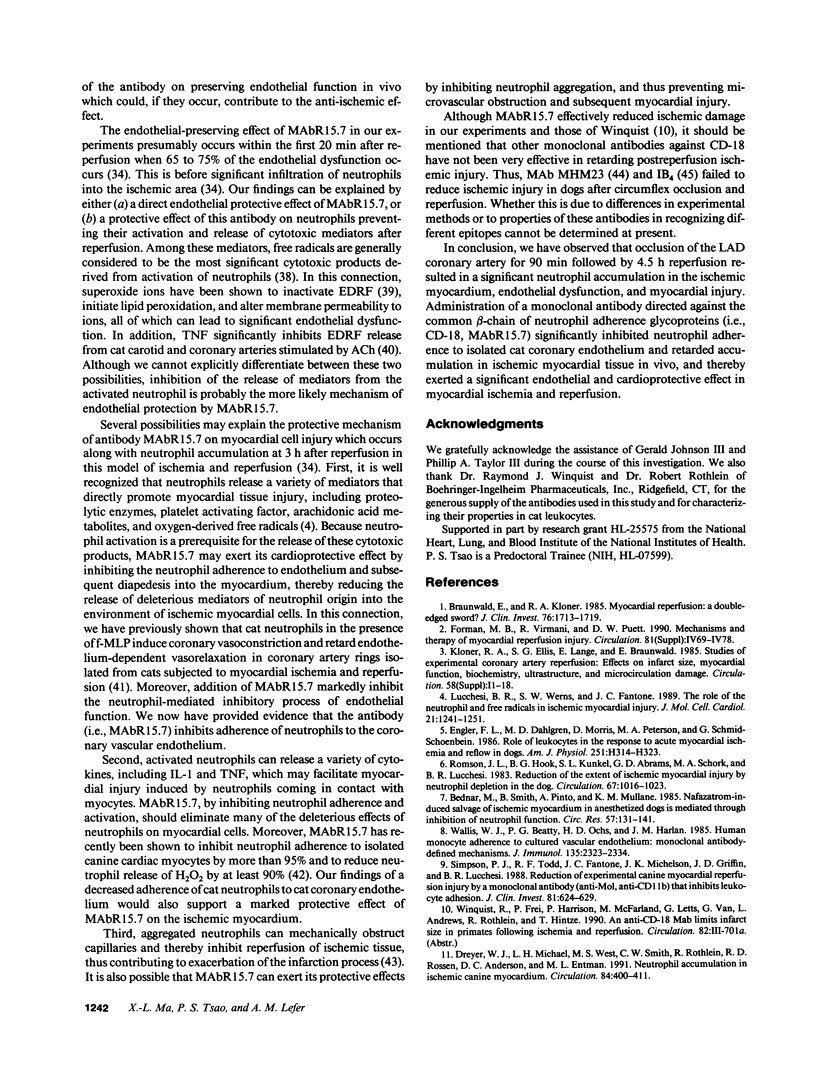
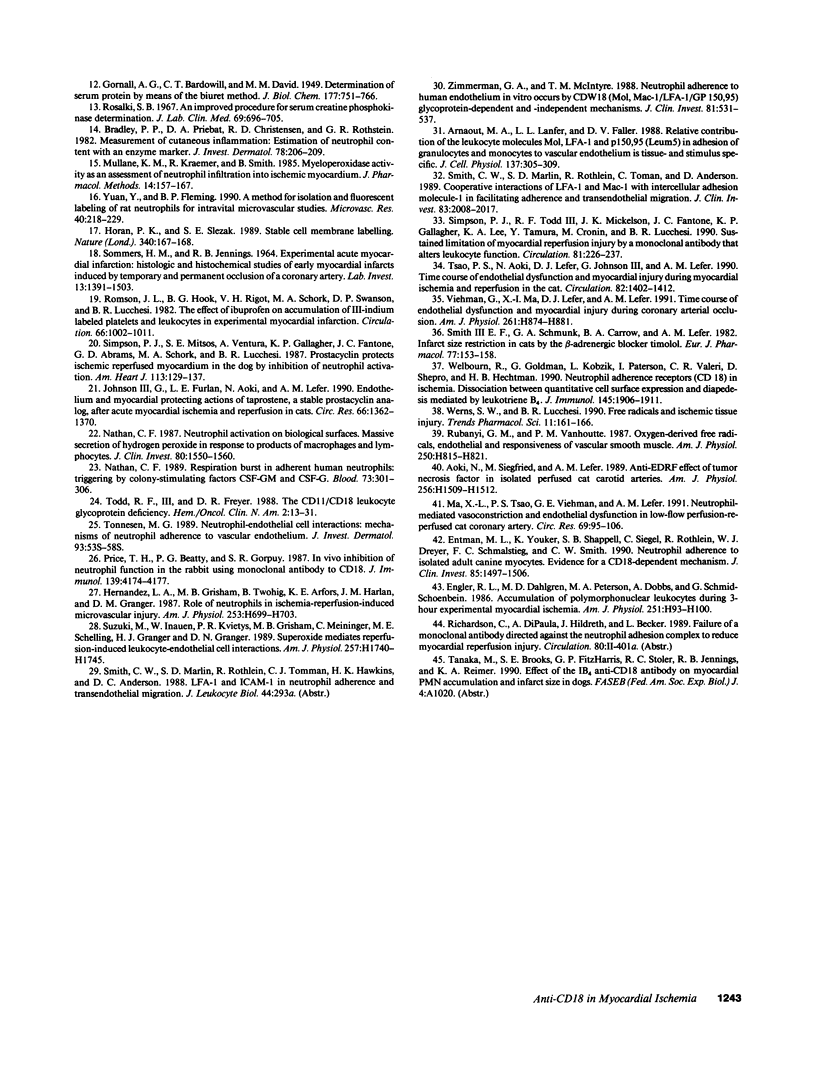
Selected References
These references are in PubMed. This may not be the complete list of references from this article.
- Aoki N., Siegfried M., Lefer A. M. Anti-EDRF effect of tumor necrosis factor in isolated, perfused cat carotid arteries. Am J Physiol. 1989 May;256(5 Pt 2):H1509–H1512. doi: 10.1152/ajpheart.1989.256.5.H1509. [DOI] [PubMed] [Google Scholar]
- Arnaout M. A., Lanier L. L., Faller D. V. Relative contribution of the leukocyte molecules Mo1, LFA-1, and p150,95 (LeuM5) in adhesion of granulocytes and monocytes to vascular endothelium is tissue- and stimulus-specific. J Cell Physiol. 1988 Nov;137(2):305–309. doi: 10.1002/jcp.1041370214. [DOI] [PubMed] [Google Scholar]
- Bednar M., Smith B., Pinto A., Mullane K. M. Nafazatrom-induced salvage of ischemic myocardium in anesthetized dogs is mediated through inhibition of neutrophil function. Circ Res. 1985 Jul;57(1):131–141. doi: 10.1161/01.res.57.1.131. [DOI] [PubMed] [Google Scholar]
- Bradley P. P., Priebat D. A., Christensen R. D., Rothstein G. Measurement of cutaneous inflammation: estimation of neutrophil content with an enzyme marker. J Invest Dermatol. 1982 Mar;78(3):206–209. doi: 10.1111/1523-1747.ep12506462. [DOI] [PubMed] [Google Scholar]
- Braunwald E., Kloner R. A. Myocardial reperfusion: a double-edged sword? J Clin Invest. 1985 Nov;76(5):1713–1719. doi: 10.1172/JCI112160. [DOI] [PMC free article] [PubMed] [Google Scholar]
- Dreyer W. J., Michael L. H., West M. S., Smith C. W., Rothlein R., Rossen R. D., Anderson D. C., Entman M. L. Neutrophil accumulation in ischemic canine myocardium. Insights into time course, distribution, and mechanism of localization during early reperfusion. Circulation. 1991 Jul;84(1):400–411. doi: 10.1161/01.cir.84.1.400. [DOI] [PubMed] [Google Scholar]
- Engler R. L., Dahlgren M. D., Morris D. D., Peterson M. A., Schmid-Schönbein G. W. Role of leukocytes in response to acute myocardial ischemia and reflow in dogs. Am J Physiol. 1986 Aug;251(2 Pt 2):H314–H323. doi: 10.1152/ajpheart.1986.251.2.H314. [DOI] [PubMed] [Google Scholar]
- Entman M. L., Youker K., Shappell S. B., Siegel C., Rothlein R., Dreyer W. J., Schmalstieg F. C., Smith C. W. Neutrophil adherence to isolated adult canine myocytes. Evidence for a CD18-dependent mechanism. J Clin Invest. 1990 May;85(5):1497–1506. doi: 10.1172/JCI114596. [DOI] [PMC free article] [PubMed] [Google Scholar]
- Hernandez L. A., Grisham M. B., Twohig B., Arfors K. E., Harlan J. M., Granger D. N. Role of neutrophils in ischemia-reperfusion-induced microvascular injury. Am J Physiol. 1987 Sep;253(3 Pt 2):H699–H703. doi: 10.1152/ajpheart.1987.253.3.H699. [DOI] [PubMed] [Google Scholar]
- Horan P. K., Slezak S. E. Stable cell membrane labelling. Nature. 1989 Jul 13;340(6229):167–168. doi: 10.1038/340167a0. [DOI] [PubMed] [Google Scholar]
- Johnson G., 3rd, Furlan L. E., Aoki N., Lefer A. M. Endothelium and myocardial protecting actions of taprostene, a stable prostacyclin analogue, after acute myocardial ischemia and reperfusion in cats. Circ Res. 1990 May;66(5):1362–1370. doi: 10.1161/01.res.66.5.1362. [DOI] [PubMed] [Google Scholar]
- Lucchesi B. R., Werns S. W., Fantone J. C. The role of the neutrophil and free radicals in ischemic myocardial injury. J Mol Cell Cardiol. 1989 Dec;21(12):1241–1251. doi: 10.1016/0022-2828(89)90670-6. [DOI] [PubMed] [Google Scholar]
- Ma X. L., Tsao P. S., Viehman G. E., Lefer A. M. Neutrophil-mediated vasoconstriction and endothelial dysfunction in low-flow perfusion-reperfused cat coronary artery. Circ Res. 1991 Jul;69(1):95–106. doi: 10.1161/01.res.69.1.95. [DOI] [PubMed] [Google Scholar]
- Mullane K. M., Kraemer R., Smith B. Myeloperoxidase activity as a quantitative assessment of neutrophil infiltration into ischemic myocardium. J Pharmacol Methods. 1985 Nov;14(3):157–167. doi: 10.1016/0160-5402(85)90029-4. [DOI] [PubMed] [Google Scholar]
- Nathan C. F. Neutrophil activation on biological surfaces. Massive secretion of hydrogen peroxide in response to products of macrophages and lymphocytes. J Clin Invest. 1987 Dec;80(6):1550–1560. doi: 10.1172/JCI113241. [DOI] [PMC free article] [PubMed] [Google Scholar]
- Nathan C. F. Respiratory burst in adherent human neutrophils: triggering by colony-stimulating factors CSF-GM and CSF-G. Blood. 1989 Jan;73(1):301–306. [PubMed] [Google Scholar]
- Price T. H., Beatty P. G., Corpuz S. R. In vivo inhibition of neutrophil function in the rabbit using monoclonal antibody to CD18. J Immunol. 1987 Dec 15;139(12):4174–4177. [PubMed] [Google Scholar]
- Romson J. L., Hook B. G., Kunkel S. L., Abrams G. D., Schork M. A., Lucchesi B. R. Reduction of the extent of ischemic myocardial injury by neutrophil depletion in the dog. Circulation. 1983 May;67(5):1016–1023. doi: 10.1161/01.cir.67.5.1016. [DOI] [PubMed] [Google Scholar]
- Romson J. L., Hook B. G., Rigot V. H., Schork M. A., Swanson D. P., Lucchesi B. R. The effect of ibuprofen on accumulation of indium-111-labeled platelets and leukocytes in experimental myocardial infarction. Circulation. 1982 Nov;66(5):1002–1011. doi: 10.1161/01.cir.66.5.1002. [DOI] [PubMed] [Google Scholar]
- Rosalki S. B. An improved procedure for serum creatine phosphokinase determination. J Lab Clin Med. 1967 Apr;69(4):696–705. [PubMed] [Google Scholar]
- Rubanyi G. M., Vanhoutte P. M. Oxygen-derived free radicals, endothelium, and responsiveness of vascular smooth muscle. Am J Physiol. 1986 May;250(5 Pt 2):H815–H821. doi: 10.1152/ajpheart.1986.250.5.H815. [DOI] [PubMed] [Google Scholar]
- SOMMERS H. M., JENNINGS R. B. EXPERIMENTAL ACUTE MYOCARDIAL INFARCTION; HISTOLOGIC AND HISTOCHEMICAL STUDIES OF EARLY MYOCARDIAL INFARCTS INDUCED BY TEMPORARY OR PERMANENT OCCLUSION OF A CORONARY ARTERY. Lab Invest. 1964 Dec;13:1491–1503. [PubMed] [Google Scholar]
- Simpson P. J., Mitsos S. E., Ventura A., Gallagher K. P., Fantone J. C., Abrams G. D., Schork M. A., Lucchesi B. R. Prostacyclin protects ischemic reperfused myocardium in the dog by inhibition of neutrophil activation. Am Heart J. 1987 Jan;113(1):129–137. doi: 10.1016/0002-8703(87)90020-2. [DOI] [PubMed] [Google Scholar]
- Simpson P. J., Todd R. F., 3rd, Fantone J. C., Mickelson J. K., Griffin J. D., Lucchesi B. R. Reduction of experimental canine myocardial reperfusion injury by a monoclonal antibody (anti-Mo1, anti-CD11b) that inhibits leukocyte adhesion. J Clin Invest. 1988 Feb;81(2):624–629. doi: 10.1172/JCI113364. [DOI] [PMC free article] [PubMed] [Google Scholar]
- Simpson P. J., Todd R. F., 3rd, Mickelson J. K., Fantone J. C., Gallagher K. P., Lee K. A., Tamura Y., Cronin M., Lucchesi B. R. Sustained limitation of myocardial reperfusion injury by a monoclonal antibody that alters leukocyte function. Circulation. 1990 Jan;81(1):226–237. doi: 10.1161/01.cir.81.1.226. [DOI] [PubMed] [Google Scholar]
- Smith C. W., Marlin S. D., Rothlein R., Toman C., Anderson D. C. Cooperative interactions of LFA-1 and Mac-1 with intercellular adhesion molecule-1 in facilitating adherence and transendothelial migration of human neutrophils in vitro. J Clin Invest. 1989 Jun;83(6):2008–2017. doi: 10.1172/JCI114111. [DOI] [PMC free article] [PubMed] [Google Scholar]
- Smith E. F., 3rd, Schmunk G. A., Carrow B. A., Lefer A. M. Infarct size restriction in cats by the beta-adrenergic blocker timolol. Eur J Pharmacol. 1982 Jan 22;77(2-3):153–158. doi: 10.1016/0014-2999(82)90011-5. [DOI] [PubMed] [Google Scholar]
- Suzuki M., Inauen W., Kvietys P. R., Grisham M. B., Meininger C., Schelling M. E., Granger H. J., Granger D. N. Superoxide mediates reperfusion-induced leukocyte-endothelial cell interactions. Am J Physiol. 1989 Nov;257(5 Pt 2):H1740–H1745. doi: 10.1152/ajpheart.1989.257.5.H1740. [DOI] [PubMed] [Google Scholar]
- Todd R. F., 3rd, Freyer D. R. The CD11/CD18 leukocyte glycoprotein deficiency. Hematol Oncol Clin North Am. 1988 Mar;2(1):13–31. [PubMed] [Google Scholar]
- Tonnesen M. G. Neutrophil-endothelial cell interactions: mechanisms of neutrophil adherence to vascular endothelium. J Invest Dermatol. 1989 Aug;93(2 Suppl):53S–58S. doi: 10.1111/1523-1747.ep12581069. [DOI] [PubMed] [Google Scholar]
- Tsao P. S., Aoki N., Lefer D. J., Johnson G., 3rd, Lefer A. M. Time course of endothelial dysfunction and myocardial injury during myocardial ischemia and reperfusion in the cat. Circulation. 1990 Oct;82(4):1402–1412. doi: 10.1161/01.cir.82.4.1402. [DOI] [PubMed] [Google Scholar]
- Viehman G. E., Ma X. L., Lefer D. J., Lefer A. M. Time course of endothelial dysfunction and myocardial injury during coronary arterial occlusion. Am J Physiol. 1991 Sep;261(3 Pt 2):H874–H881. doi: 10.1152/ajpheart.1991.261.3.H874. [DOI] [PubMed] [Google Scholar]
- Wallis W. J., Beatty P. G., Ochs H. D., Harlan J. M. Human monocyte adherence to cultured vascular endothelium: monoclonal antibody-defined mechanisms. J Immunol. 1985 Oct;135(4):2323–2330. [PubMed] [Google Scholar]
- Welbourn R., Goldman G., Kobzik L., Paterson I., Valeri C. R., Shepro D., Hechtman H. B. Neutrophil adherence receptors (CD 18) in ischemia. Dissociation between quantitative cell surface expression and diapedesis mediated by leukotriene B4. J Immunol. 1990 Sep 15;145(6):1906–1911. [PubMed] [Google Scholar]
- Werns S. W., Lucchesi B. R. Free radicals and ischemic tissue injury. Trends Pharmacol Sci. 1990 Apr;11(4):161–166. doi: 10.1016/0165-6147(90)90068-J. [DOI] [PubMed] [Google Scholar]
- Yuan Y., Fleming B. P. A method for isolation and fluorescent labeling of rat neutrophils for intravital microvascular studies. Microvasc Res. 1990 Sep;40(2):218–229. doi: 10.1016/0026-2862(90)90021-i. [DOI] [PubMed] [Google Scholar]
- Zimmerman G. A., McIntyre T. M. Neutrophil adherence to human endothelium in vitro occurs by CDw18 (Mo1, MAC-1/LFA-1/GP 150,95) glycoprotein-dependent and -independent mechanisms. J Clin Invest. 1988 Feb;81(2):531–537. doi: 10.1172/JCI113351. [DOI] [PMC free article] [PubMed] [Google Scholar]


